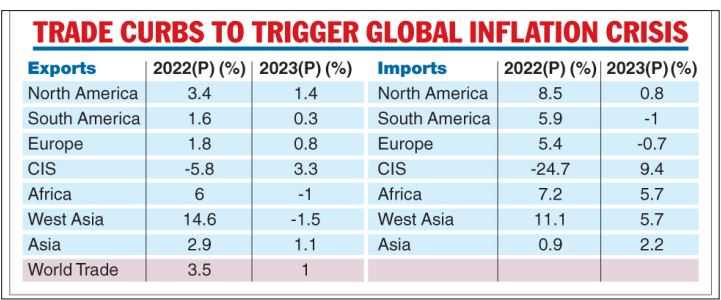The World Trade Organization has forecast a slowdown of global trade growth next year, as sharply higher energy and food prices and rising interest rates curb import demand, and warned of a possible contraction if the war in Ukraine worsens.
The Geneva-based trade body said on Wednesday that merchandise trade would increase by 3.5 per cent this year, up from its April estimate of 3 per cent. However, for 2023, it sees trade growth of just 1 per cent, compared with a previous forecast of 3.5 per cent.
The WTO said there was high uncertainty over its forecasts. It provided a band of trade growth expansion of 2 per cent to 4.9 per cent for this year and of -2.8 per cent to 4.6 per cent for 2023.
“The picture for 2023 has darkened considerably,” World Trade Organization director-general Ngozi Okonjo-Iweala told a news conference, adding that risks for next year’s forecast were more on the downside.
“If the war in Ukraine worsens, rather than gets better, that’s going to have a huge impact,” she said.
Weather events hitting food-producing regions or damaging energy export infrastructure could further hit trade growth, along with weakness in China, where Covid-19 outbreaks have disrupted production. She said the world needed a more diversified and less concentrated base for production of goods and services, which should boost growth, increase resilience and promote longterm price stability by mitigating exposure to extreme weather events and local disruptions.
She also warned against the “tempting response” to resort to trade restrictions, saying curbs imposed by various countries on food and fertiliser exports had dropped from 57 to 42 in the past month, but then rose back to 53 due to new measures.
“These would only deepen inflationary pressures and reduce living standards and would likely make us more rather than less vulnerable to the crisis we are grappling with,” she told a news conference.
The WTO’s forecast does not cover services, but the WTO said tourist arrivals were likely to fall after tripling in the first seven months of 2022. Lower shipping rates, it said, might have been greeted before as a sign of supply chains improvements, but was probably more the result of cooling demand.
While global trade has rebounded from a deep slump in the early days of the Covid-19 pandemic, US Federal Reserve and other central bank moves to choke off inflation through higher interest rates are likely to have knock-on effects for crucial spending in areas such as housing, motor vehicle sales and bond prices, WTO says.
The trade body said, however, that new information from purchasing managers, on final goods prices, and an index of input prices suggested that inflationary pressures “may have peaked” — a factor that could influence decision-making from central bankers in the months ahead. Shrinking demand and the continued fallout from the coronavirus pandemic is likely to crimp exports out of China, the world’s manufacturing powerhouse, the WTO said.
WTO senior economist Coleman Nee said Russia hasn’t reported its trade figures to the global trade body since January, clouding the picture about how Russian export and import activities were faring. The WTO said Confederation of Independent States countries — made up of most of the former Soviet states — saw quarter-on-quarter exports drop nearly 10.5 per cent in the second quarter.
Last month the trade ministers of G20 countries discussed ways to strengthen the WTO’s dispute settlement mechanism to make it more accessible and efficient. The meeting was convened by US Trade Representative Katherine Tai on the sidelines of the G20 Ministerial Meeting in Bali, Indonesia. Global trade experts term the dispute settlement mechanism of the WTO as the “jewel in the crown”.

There are two main ways to settle a dispute once a complaint is filed at the WTO —the countries find a mutually agreed solution, particularly during the phase of bilateral consultations; and through adjudication which includes ruling by a panel and if not satisfied, challenging that ruling at the appellate body.
The appellate body is the apex institution to adjudicate disputes. Smooth functioning of this mechanism hit a roadblock, when the US blocked appointments of members in the appellate body (AB).
Though the AB stopped functioning from December 10, 2019, the panels are still working. Since December 2019, as many as 24 appeals have been filed in the AB. Out of this, four are filed by India that includes Japan’s case on India’ssafeguard measures on steel and the US case against India’sexport subsidies.
Developing countries feel a two-tier system is basic for the functioning of the dispute settlement mechanism.










